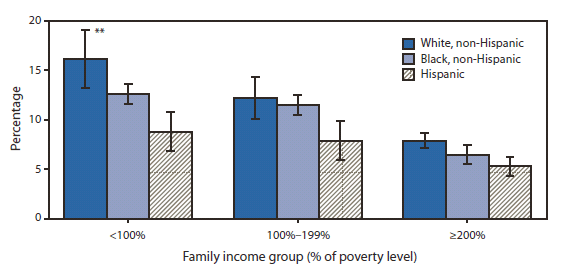Persons using assistive technology might not be able to fully access information in this file. For assistance, please send e-mail to: mmwrq@cdc.gov. Type 508 Accommodation and the title of the report in the subject line of e-mail.
QuickStats: Percentage of Children Aged 5--17 Years Ever Receiving a Diagnosis of Learning Disability,* by Race/Ethnicity† and Family Income Group§ --- National Health Interview Survey,¶ United States, 2007--2009

* Based on parental response to the following question: "Has a representative from a school or a health professional ever told you that [child] had a learning disability?"
† White and black children are non-Hispanic children with a single race reported. Hispanic children might be of any race.
§ Family income group is based on family income and family size using the U.S. Census Bureau poverty thresholds. Family income was imputed when information was missing, using multiple imputation methodology.
¶ Estimates were based on household interviews of a sample of the U.S. civilian noninstitutionalized population. Denominators for each category exclude persons for whom data were missing.
** 95% confidence interval.
During 2007--2009, among children with family incomes <100% of the poverty level, non-Hispanic white children (16%) and non-Hispanic black children (13%) were more likely to have ever received a diagnosis of learning disability than Hispanic children (9%). Among those with family income 100%--199% of the poverty level, the percentage with a learning disability was higher for non-Hispanic white and non-Hispanic black children (both 12%) than for Hispanic children (8%). Among children with family income ≥200% of the poverty level, non-Hispanic white children (8%) were more likely to have been diagnosed with learning disability than Hispanic children (5%). For children in all three racial/ethnic groups, the percentage of children ever receiving a diagnosis of learning disability decreased as family income increased.
Sources: CDC. Health Data Interactive. Available at http://www.cdc.gov/nchs/hdi.htm.
National Health Interview Survey 2007--2009 data. Available at http://www.cdc.gov/nchs/nhis.htm.
Alternate Text: The figure above shows the percentage of children aged 5-17 years ever receiving a diagnosis of learning disability, by race/ethnicity and family income group in the United States during 2007-2009. Among children with family incomes <100% of the poverty level, non-Hispanic white children (16%) and non-Hispanic black children (13%) were more likely to have ever received a diagnosis of learning disability than Hispanic children (9%). For all three racial/ethnic groups, the percentage of children ever receiving a diagnosis of learning disability decreased as family income increased.
Use of trade names and commercial sources is for identification only and does not imply endorsement by the U.S. Department of
Health and Human Services.
References to non-CDC sites on the Internet are
provided as a service to MMWR readers and do not constitute or imply
endorsement of these organizations or their programs by CDC or the U.S.
Department of Health and Human Services. CDC is not responsible for the content
of pages found at these sites. URL addresses listed in MMWR were current as of
the date of publication.
All MMWR HTML versions of articles are electronic conversions from typeset documents.
This conversion might result in character translation or format errors in the HTML version.
Users are referred to the electronic PDF version (http://www.cdc.gov/mmwr)
and/or the original MMWR paper copy for printable versions of official text, figures, and tables.
An original paper copy of this issue can be obtained from the Superintendent of Documents, U.S.
Government Printing Office (GPO), Washington, DC 20402-9371;
telephone: (202) 512-1800. Contact GPO for current prices.
**Questions or messages regarding errors in formatting should be addressed to
mmwrq@cdc.gov.


